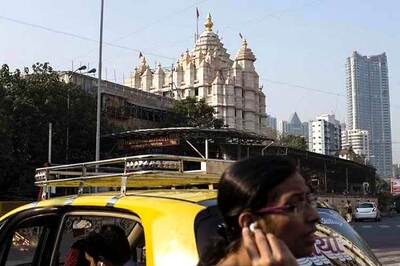
views
Srinagar: Four years after he acted in the film ‘Haider’ — a tragic story of a boy caught in the quagmire of conflict — 15-year-old Saqib Bilal faced a similar tragic end. Saqib was among the three militants killed in an encounter in Srinagar’s Mujgund on Sunday.
Saqib and his friend Mudasir Parray went missing from their home in Bandipora district’s Hajin on August 31 and joined the Lashkar-e-Taiba. They were killed on Sunday after an 18-hour-long gunbattle on the outskirts of Srinagar city, along with a Pakistani militant commander, Ali Bhai.
Mudasir and Saqib used to play football together for hours in Hajin’s Eidgah. It was the same place where thousands of people gathered to bid them farewell.
“On August 31, Mudasir was playing football in the Eidgah. Saqib came and they left together,” said Umar, another football player. That was the day the two boys disappeared and joined militancy. Their families ran from pillar to post to look for them, including a visit to the militancy hotbed in south Kashmir, but couldn’t trace them.
However, a week ago, Hajin was stunned to see the photographs of two cheerful, football-loving children brandishing AK-47 rifles surface on the internet. The town has been an erstwhile bastion of Ikhwan, a pro-government militia aimed at counter-insurgency, which is accused of grave human rights violations.
When Saqib had appeared in the film ‘Haider’ in 2014, he was appreciated for his acting. A bright student who had passed his Class 10 exams with good marks, he had also participated in a play in Kerala. Saqib then joined a local school where he opted for science stream. “He wanted to be an engineer. He loved football and acting,” his grief-stricken father Bilal Ahmad Sheikh told News18. “He would never talk about militancy or the conflict. His life was filled with his own adventures.”
Sheikhs live opposite the house of slain Ikhwan commander Kuka Parray, who was notorious for killing militants.
Saqib’s family says it was clueless about the conflict in his mind until he left home. “Our town is notorious for militancy and the counter-militancy past. But I never realised my son would go to this extreme. I had never spoken with him about these things,” said Bilal.
The story of Mudasir is similar. Besides attending a school, Mudasir also worked as a labourer to support his family. He is survived by his ailing parents who recently underwent surgeries, a handicapped brother and a 10-year-old sister.
“He used to work as labourer and would give the money to his mother,” said Rasheed Ahmad Parray, Mudasir’s father. “The work would affect his studies. But he was a hardworking boy and wanted to help me,” he said.
Mudasir’s family lives in a shanty, which houses his football shoes in one corner. “He worked in the orchards and got these shoes from the money that he earned,” said Rasheed.
The neighbours who would watch him play football for hours were hopeful that he would be a famous footballer one day. But fate had something else in store for him.
In 2016, when Mudasir was just 12 years old, he was arrested in a stone-throwing case and was lodged in a police station for over a week. “The police officers told me to counsel him and let him go,” said Rasheed.
He feels that Mudasir joined militancy after the killing of their relative, 19-year-old Abid Hamid Mir, in August 2017. Mir was killed in an encounter in Sopore’s Amargar, 25km away from Hajin. Mudasir’s friends say he visited the encounter site the next day. His family believes that this was his turning point. “He was very attached to Abid,” said his father. Rasheed firmly believes it was his son’s choice to die like this.
On Monday, thousands of people gathered at the funeral of the two teenagers whose death depicts the tragedy of Kashmir. “A 14-year-old boy with an AK47 in hand depicts our collective failure to give these kids hope of life and future. Mudasir was too young to sacrifice his precious life for a cause he hardly understood. Rest in peace,” journalist Shams Irfan wrote on Sunday.
The Minor Militants
This is not the first time teenage boys have picked up guns in Kashmir. The poster boy of new age militancy in Kashmir, Burhan Wani, was only 15 when he joined the ranks in October 2010.
International laws prohibit the recruitment of juveniles into any armed conflict and seek their protection. Under the Statute of the International Criminal Court, “conscripting or enlisting children into armed forces or groups constitutes a war crime in both international and non-international armed conflicts.” But in Kashmir, age seems to be just a number.
On May 27, 2017, Faizan Ahmad Bhat was killed two months after joining militancy. He was 15 years old. Families of the minor boys joining militant ranks have blamed the “atrocities” of the security forces for compelling them to take extreme steps.
Dawood Sheikh, who joined Hizbul Mujahideen in 2014, was 14 when he joined the militant ranks. His family said the torture by the forces compelled him to take the extreme step. He was killed in 2016.
At the start of the insurgency in early 1990s, young boys were recruited in militant groups in large numbers. A lot of them were minors and they were mostly killed immediately.
In November 2015, a family from Nagam village of south Kashmir's Anantnag identified their son in an Al-Qaeda video. In the video, the Al Qaeda claimed that one of their operatives killed in a US drone attack in Pakistan’s North Waziristan was Muhammad Ashraf Dar from Kashmir’s Anantnag. Dar was 15 years old when he crossed over to Pakistan in 2001 and underwent arms training.




















Comments
0 comment